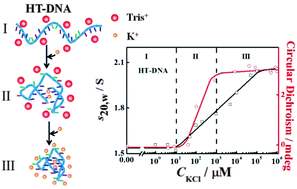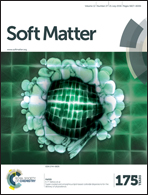The effects of monovalent metal ions on the conformation of human telomere DNA using analytical ultracentrifugation†
Abstract
A human telomere DNA segment (HT-DNA) can fold into a G-quadruplex in the presence of some monovalent cations. These cations can interact with the phosphate groups of the DNA segment and/or with the O6 oxygen atom of guanines, which are called non-specific interactions and specific interactions, respectively. However, until now how these two interactions affect the structure of HT-DNA has not been well understood. In this study, a combination of analytical ultracentrifugation (AUC) and circular dichroism (CD) was used to explore the effects of these two interactions on the structure of a 22-mer single-stranded DNA with a sequence of 5′-AGGG(TTAGGG)3-3′. The results showed that the standard sedimentation coefficient (s20,w) of HT-DNA starts to increase when the concentration of potassium ions (CK+) is higher than 10.0 µM due to the formation of a G-quadruplex through specific interactions. Whereas, for a control DNA, a higher CK+ value of 1.0 mM was needed for increasing s20,w due to non-specific interactions. Moreover, potassium ions could promote the formation of the G-quadruplex much more easily than lithium, sodium and cesium ions, presumably due to its appropriate size in the dehydrated state and easier dehydration. The molar mass of DNA at different cation concentrations was nearly a constant and close to the theoretical value of the molar mass of monomeric HT-DNA, indicating that what we observed is the structural change of individual DNA chains.


 Please wait while we load your content...
Please wait while we load your content...